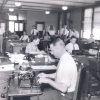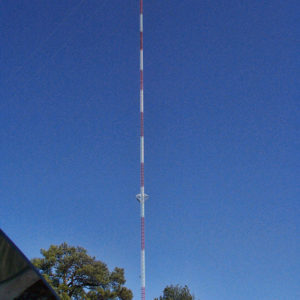calsfoundation@cals.org
KATV Tower
The KATV tower was a 2,000-foot-tall (609.6 meters) television antenna that stood just north of Redfield (Jefferson County), about one-quarter mile east of Interstate 530. Before its collapse in 2008, the tower ranked among the tallest manmade structures in the world and stood as a prominent local landmark, marking the approximate halfway point for drivers traveling between Little Rock (Pulaski County) and Pine Bluff (Jefferson County).
Upon its completion on the late summer of 1965, the KATV tower was the third-tallest manmade structure in the world, surpassed only by the KVLY-TV and KXJB-TV television masts in North Dakota. By 2008, it shared the rank of fifth-tallest manmade structure in the world, as it was the first of many other 2,000-foot-tall masts that were eventually constructed across the United States. Besides the two masts in North Dakota, the only other structures surpassing the KATV tower in height at the time of its collapse were both constructed in 2000—the KXTV/KOVR television mast in California, and the marginally taller Petronius drilling platform in the Gulf of Mexico, located off the Louisiana coast.
As constructed, the antenna was a guyed mast that relied upon high-tension cables to support the structure. These cables—called guy wires—anchored the tower to the ground at diagonal angles, which enabled it to remain upright while providing stability against lateral forces, such as high winds. On January 11, 2008, the tower suddenly collapsed while workers were restringing the guy wires; the tower had begun to shake following the loosening of an old wire, leading to its collapse. In the event of structural failure, the tower was designed to break into smaller segments and crumble straight downward, rather than remaining erect and crashing in an outward direction, like a falling tree. The tower fell straight downward (as designed), and only minor injuries were sustained by one maintenance worker. The exact cause of the collapse remains unknown.
The collapse disrupted the analog and digital feeds of KATV, as well as the analog signal of KETS, the Little Rock affiliate of the Arkansas Educational Television Network (AETN), which leased space on the tower at that time. Comcast reported that its subscribers experienced no interruption of the regular KATV signal but did lose the high-definition and twenty-four-hour news signals from KATV. Comcast and local competitors KARK and KTHV offered immediate assistance in restoring the KATV signal to the air. The KATV digital feed was quickly restored, but the analog signal did not resume until January 21, when KATV began utilizing KTHV’s auxiliary antenna on Shinall Mountain. KETS expected to restore its analog signal by March, but its return was delayed until June 13, when a temporary transmitter was installed on the Clear Channel broadcasting tower, also near Redfield.
KATV decided not to reconstruct another tower at Redfield and instead built a replacement on Shinall Mountain near the broadcast masts of most other Little Rock stations. The new antenna began broadcasting on February 1, 2009.
For additional information:
“Flurry of Hands Cues Surprised Moderator New TV Tower on Air.” Arkansas Gazette, September 13, 1965, p. 4B.
Hinkel, Nate. “UPDATED: KATV Tower Collapses; Competitors, Comcast Try to Help.” Arkansas Business, January 11, 2008. http://www.arkansasbusiness.com/article/43722/updated-katv-tower-collapses-competitors-comcast-try-to-help (accessed September 14, 2021).
KATV Antenna Structure Registration. Federal Communications Commission. http://wireless2.fcc.gov/UlsApp/AsrSearch/asrRegistration.jsp?regKey=603520 (accessed September 14, 2021).
“KATV Little Rock Tower Falls, 1 Injured.” TVNewsCheck. http://www.tvnewscheck.com/article/18890/katv-little-rock-tower-falls-1-injured (accessed September 14, 2021).
“KATV Receives Tower Permit.” Arkansas Gazette, June 23, 1965, pp. 1A, 2A.
“KATV Tower.” Structurae. http://structurae.net/structures/katv-tower (accessed September 14, 2021).
Adam Miller
Austin, Texas
 Divergent Prosperity and the Arc of Reform, 1968–2022
Divergent Prosperity and the Arc of Reform, 1968–2022 Mass Media
Mass Media Science and Technology
Science and Technology KATV Tower
KATV Tower 




I was the transmitter supervisor at KTHV when KATVs 2,000-foot tower came down. I had saved the manuals for the KTHV auxiliary antenna. When the antenna was built, RCA made two types: a high-band and a low-band turnstile antenna. It was tuned on site for the station frequency, but it still had a broad band width. When KATV lost its antenna, I talked to management about letting KATV use a port in air combiner to put them back on the air. Tests were run that found I was correct. So in the end, we had a backup antenna for analog 11 and digital 12. Plus analog 7. At this time, the old six-bay antenna is still in use for an aux digital antenna.